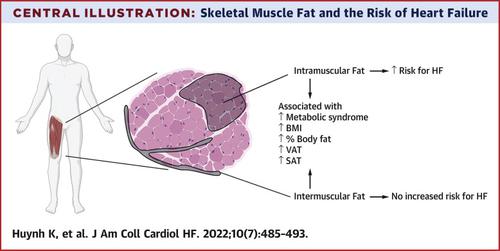JACC: Heart Failure ( IF 10.3 ) Pub Date : 2022-06-27 , DOI: 10.1016/j.jchf.2022.04.012 Kevin Huynh 1 , Colby Ayers 2 , Javed Butler 3 , Ian Neeland 4 , Stephen Kritchevsky 5 , Ambarish Pandey 2 , Gregory Barton 6 , Jarett D Berry 2

|
Background
Excess adiposity is a well-known risk factor for heart failure (HF). Fat accumulation in and around the peripheral skeletal muscle may further inform risk for HF.
Objectives
The purpose of this study was to evaluate the association between intramuscular and intermuscular fat deposition and incident HF in a longitudinal cohort of community-dwelling older adults.
Methods
The associations of intramuscular and intermuscular fat with incident HF were assessed using Cox models among 2,399 participants from the Health ABC (Health, Aging and Body Composition) study (70-79 years of age, 48% male, 40.2% Black) without baseline HF. Intramuscular fat was determined by bilateral thigh muscle density on computed tomography and intermuscular fat area was determined with computed tomography.
Results
After a median follow-up of 12.2 years, there were 485 incident HF events. Higher sex-specific tertiles of intramuscular and intermuscular fat were each associated with HF risk. After multivariable adjustment for age, sex, race, education, blood pressure, fasting blood sugar, current smoking, prevalent coronary disease, and creatinine, higher intramuscular fat, but not intermuscular fat, was associated with higher risk for HF (HR: 1.34 [95% CI: 1.06-1.69]; P = 0.012, tertile 3 vs tertile 1). This association remained significant after additional adjustment for body mass index (HR: 1.32 [95% CI: 1.03-1.69]), total percent fat (HR: 1.33 [95% CI: 1.03-1.72]), visceral fat (HR: 1.30 [95% CI: 1.01-1.65]), and indexed thigh muscle strength (HR: 1.30 [95% CI: 1.03-1.64]). The association between higher intramuscular fat and HF appeared specific to higher risk of incident HF with reduced ejection fraction (HR: 1.53 [95% CI: 1.03-2.29]), but not with HF with preserved ejection fraction (HR: 1.28 [95% CI: 0.82-1.98]).
Conclusions
Intramuscular, but not intermuscular, thigh muscle fat is independently associated with HF after adjustment for cardiometabolic risk factors and other measurements of adiposity.
中文翻译:

大腿肌肉脂肪浸润与心力衰竭之间的关联
背景
过度肥胖是众所周知的心力衰竭(HF)危险因素。周围骨骼肌内部和周围的脂肪堆积可能进一步提示心力衰竭的风险。
目标
本研究的目的是评估社区老年人纵向队列中肌内和肌间脂肪沉积与心力衰竭之间的关联。
方法
使用 Cox 模型评估了 Health ABC(健康、衰老和身体成分)研究的 2,399 名参与者(70-79 岁,48% 男性,40.2% 黑人)中无基线心力衰竭的肌内和肌间脂肪与心力衰竭的关联。通过计算机断层扫描双侧大腿肌肉密度确定肌内脂肪,并通过计算机断层扫描确定肌间脂肪面积。
结果
中位随访 12.2 年后,共发生 485 起心力衰竭事件。肌内脂肪和肌间脂肪的性别特异性三分位数较高均与心力衰竭风险相关。对年龄、性别、种族、教育程度、血压、空腹血糖、当前吸烟、流行冠心病和肌酐进行多变量调整后,较高的肌内脂肪(而非肌间脂肪)与较高的心力衰竭风险相关(HR:1.34 [ 95% CI:1.06-1.69];P = 0.012,三分位数 3 与三分位数 1)。在对体重指数(HR:1.32 [95% CI:1.03-1.69])、总脂肪百分比(HR:1.33 [95% CI:1.03-1.72])、内脏脂肪(HR:1.30)进行额外调整后,这种关联仍然显着。 [95% CI: 1.01-1.65]),以及指数大腿肌肉力量 (HR: 1.30 [95% CI: 1.03-1.64])。较高的肌内脂肪与心力衰竭之间的关联似乎特定于射血分数降低的心力衰竭发生风险较高(HR:1.53 [95% CI:1.03-2.29]),但与射血分数保留的心力衰竭无关(HR:1.28 [95% CI:1.03-2.29]) CI:0.82-1.98])。
结论
在调整心脏代谢危险因素和其他肥胖测量后,肌肉内(而非肌间)大腿肌肉脂肪与心力衰竭独立相关。











































 京公网安备 11010802027423号
京公网安备 11010802027423号